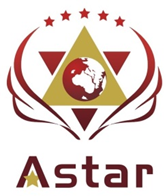
社安金明年可能调升8.6% 42年最高 平均增142元
世界新闻网
5/12/2022
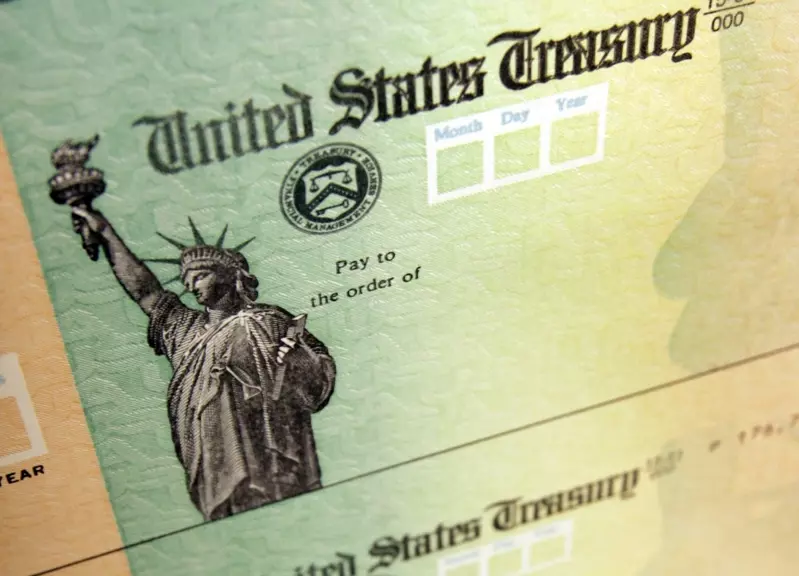
在劳工部公布4月消费者物价指数(CPI)的同日,非营利组织「长者联盟」(Senior Citizens League)预测,社安金生活费明年可能上调8.6%,刷新1981年以来最大增幅。
哥伦比亚广播公司(CBS News)引述长者联盟的数据报导,社安金支票通常每月约1658元,以8.6%预估涨幅推算,2023年初每月将增加142.6元,支票总额上看1800元。
长者联盟的社会保障和医疗保险政策分析师玛莉.强纳森(Mary Johnson)说,这项预估的依据是最新通膨数据,包括政府11日公布、涵盖商品及服务的4月消费者物价指数;4月CPI相比去年同期增8.3%,略低于3月8.5%的年增率。
社安金生活费调整(cost-of-living adjustment,简称COLA)则是以「城市职工消费者物价指数」(Consumer Price Index for Urban Wage Earners and Clerical Workers,简称CPI-W)为依据;4月CPI-W较去年同期涨8.9%,年增幅略高于更广泛的物价指数。

全美共6900万人领取社安金,1月生活费上调5.9%,创1982年以来最大增幅,但今年通膨远高于生活费调幅,导致实际购买力不足。
强纳森说:「5.9%不足以赶上通膨率,若领固定薪水会很困难,我们正处于部分极端的情况。」
社安署(SSA)今年10月将根据7月到9月的通膨数据设置2023年COLA,届时公布的调幅可能与长者联盟目前估值有所出入;强纳森去年预测2022年调幅6.1%,实际调5.9%。
社安署数据显示,1980年和1981年COLA分别增14.3%和11.2%,那是1975年以来两次最大增幅;在那之前通过立法制定涨幅,而非考量通膨指数。
强纳森说,社安金实质购买力自2000年以来下降40%,部分归因于生活费涨幅跟不上通膨;长者联盟盼社安署以更适合老人的「老人消费物价指数」(Consumer Price Index for the Elderly)作为COLA年增幅计算依据,该指数较重视医疗保健等成本。
随着实质购买力下降,越来越多老人依赖食物银行和粮食券;长者联盟调查发现,1月有45%受访者靠这些资源获取食物,是去年10月的两倍。
强纳森说:「这很悲哀,让我想哭。」

移民不足致劳动力短缺 各行业抢人 房价也上涨
世界新闻网
5/07/2022

专家指出,美国劳动力短缺,部分原因是移民政策及步调双双放缓。前总统川普执政期间逐渐减少移民,加上新冠疫情让移民程序几乎停摆18个月,据估计,现在外来移民足足少了200万人。劳动力短缺下,从肉类包装到房屋建筑业,都在大抢工人,进一步导致供应短缺和价格上涨;德州达拉斯地区更传出房屋标准造价大涨15万元。
戴维斯加州大学经济学者佩里(Giovanni Peri) 表示,「这消失的200万移民,是美国劳动力短缺的部分原因;短期内,我们将通过提高工资和货品价格,来因应劳动力市场短缺的问题。」美国正面临40年来最高通货膨胀;劳动力不足、疫情破坏供应链、俄罗斯入侵乌克兰后能源和大宗商品价格飙升,都是影响因素。
不过,倡议减少移民的移民研究中心(Center for Immigration Studies)研究员卡马罗塔(Steve Camarota)认为,美国在拜登总统领导下,非法移民激增,将弥补疫情带来的任何劳动力不足。研究人员表示,移民正迅速恢复到疫情前水平,但美国需要大幅加速弥补劳动力缺口。部分经济学家预测,鉴于过去20年美国出生人数急剧下降,到2025年,潜在劳动力总体数量将开始减少。
Healthcare Certification and ESL Programs
与此同时,美国政治大环境对增加移民的兴趣也在减弱中。民主党执政迄今,并未试图推动更多新移民来美的重大立法。盖洛普最近民意调查还显示,对非法移民的担忧已达到两年来最高水平。随着11月党内初选迫近,民主党人对拜登政府试图结束与疫情相关的庇护限制,立场也越来越分歧。
经济学者、前小布希政府前官员、中右翼美国行动论坛(American Action Forum)主席霍尔茨-埃金(Douglas Holtz-Eakin)承认,移民政策不太可能发生变化,「双方都锁定这样的基础」。
美国从迎接外来移民态度转变,让德州部分企业主深感苦恼;达拉斯地区建筑业主科雷亚(Joshua Correa)说,他和承包商都在努力找人,不管是石膏板工、水管工或电工皆然,工程项目因此延误两、三个月,「作为建筑商和开发商,我们的感受很深刻,消费者也会因此付出代价。」
为弥补因劳动力短缺而增加的成本,科雷亚已将建造房屋标准价格从50万元提高到约65万元。他说:「移民对我们美国的劳动力非常重要,我们真的得靠它才行。」
劳工首季薪资增长创纪录 仍追不上物价
世界新闻网
4/29/2022

联邦劳工部29日公布今年首季美国劳工薪酬数据,指出劳工的薪酬及福利均以创纪录的速度增长,但同时给通货膨胀带来压力,即使薪酬大幅增长了,仍追不上物价上涨的步伐。
劳工部指出,雇主及政府今年首季在劳工成本上的支出,未经季节性调整下,比去年同期增加4.5%,这是自2001年以来增长最快的纪录,也超过去年第四季的4.0%增长率。若经季节性调整,劳工的薪酬增长1.4%,超过去年第四季的增长1.0%,这反映工资、薪金和福利均有所提高。
家庭收入多了自然愿意花费,3月消费者支出增长1.1%,主要是在旅行、餐饮等方面,汽油及食品等也增加支出,显示出他们在40年来最高通膨率的情况下的消费意愿不减。
这将会进一步刺激通膨,劳工薪酬大幅增长,增强了议价能力,但也使通膨保持在高位。有经济学家指出,企业为了补偿更高的劳动力成本,自然要将物价的上涨转嫁给消费者。
商务部指出,3 月消费者价格同比上涨6.6%,高于2月经修正后的6.3%涨幅,也是自 1982年以来的最快速度。

造成劳工薪酬大幅上涨的主要原因是劳动力短缺,求过于供情况严重。劳工部指出,2月有1130万份职位空缺,但只有630万人失业寻找工作。转换公司也是雇员保持工资增长的关键因素,他们换公司后往往会获得大幅加薪,因此雇主必须提高工资以挽留员工。
紧张的劳动力市场,雇主不仅提高工资,还要提供更丰厚的福利吸引工人。今年首季的福利增长了1.8%,是自2004年以来最快的季度成长。其中管理、销售及制造业的员工福利增长最大。
雇主们表示,为了弥补劳工力成本,自然要提高商品及服务价格,加上供应链中断、俄乌战争推高能源价格等等,通膨进一步飙涨自然无可避免。
结果是即使劳工的工资收入大幅增加,但仍追不上不断上涨的物价。劳工部的数据指出,首季度私营企业的工资和薪金,经通膨调整后反而同比下降3.3%。
有经济学家认为,随着新冠疫情缓和及家庭储蓄减少,预料愈来愈多人重返职场,当更多人可以填补空缺时,雇主支付工资的压力也会减轻。

物价涨人工贵 南加华人餐厅举步维艰 想卖卖不出去
世界新闻网
4/26/2022

经历了疫情冲击的一些华人餐厅,并没有迎来餐饮业报复性消费的春天。不少业主表示,物价涨、人工贵等各种现实问题,让他们的餐厅举步维艰,更有经营了十多年的南加华人老餐厅,在面临亏本的情况下准备出让,但没想到在市场上卖了半年,始终没有人愿意接手。
洛杉矶县阿罕布拉市(Alhambra)居民陈先生,在洛杉矶市拥有一家中餐厅,半年前,他就将这家已经营十多年的餐厅放到市场上转让,但至今无人问津。陈先生无奈地说,「我们的餐厅很难再生存下去,一直都在亏钱,亏了一年多,我就看到银行账户的数字没有上涨,不知道钱都去哪了。」
后疫情时代加州全面开放后,到餐厅吃饭的人开始逐渐恢复,生意虽好转,但一个严峻的问题扑面而来,通货膨胀导致物价疯涨,直接影响餐厅的经营成本。陈先生说,「供货商把价格涨得非常离谱,涨得我都不想看了,肉类涨得最厉害。」他表示一年前,餐厅批发的鸡翅一箱三四十元,当时最便宜时一磅不到一元,但现在高达100多元一箱,直接翻了几倍。除了肉类,食用油也翻倍涨价,「一年前一桶食用油19元,现在最高要四五十元,涨了不止一倍多。」
最让陈先生头疼的是,近一年很难招到员工,很少有人愿意到餐厅工作,「我们真的很惨,一直在涨工资,提高时薪,甚至给员工付现金,但还是没有人愿意做。」陈先生的餐厅以前是八名员工,目前只有五名,「有些新人到餐厅做了一天就不愿做了,说实话,到了后面我都不想招人了,不愿再继续做下去。」
对于人工严重短缺的问题,采访中,陈先生向记者抱怨,并希望通过媒体发出自己的声音,他认为政府如果能够打开工作移民这扇大门,很多困境都会改善,「如果工作移民的人不断进来,劳动力就会很快得到解决,其他困难也会随之改善,我们最主要的就是人工缺少,没有人竞争,所以大家都不愿工作。」
「物价贵,人工贵,什么都贵。」陈先生悲观地说,如今经营餐厅的很多朋友都面临同样困境,「我认识很多餐厅老板,他们的店在洛杉矶市华埠(Chinatown)一带,不少人现在不想做,想把餐厅卖出去,因为实在做不下去。」但很多人就像陈先生一样,餐厅放到市场卖了半年,却至今没有人愿意接手。
陈先生感慨道,人们以后想在洛杉矶吃到好的中餐的机会会越来越少,因为烧菜的大师傅老了退休了,后继无人,「就像我儿子这一代,他们都不愿意做餐厅,只有新的工作移民进到美国市场,餐饮业才有希望,否则大家很快都没有好东西吃了。」
相关媒体报导指出,自疫情趋缓、经济复苏以来,就业市场的需求大增,目前全美约有200万个职缺找不到人。专家认为,这与疫情期间美国移民人数减少等因素有关。数据显示,2020年进入美国的移民人数已下降到2016年的一半,2021的移民人数更是降至2016年的四分之一。

物价还会再涨 全美四成小企业 打算近期涨价10%以上
世界新闻网
4/25/2022

在美国面临40年来最严重通膨之际,最新调查显示,美国约40%的小企业打算涨价10%以上。这凸显民众将继续见到一波物价上涨的情况。
根据全美独立企业联盟(NFIB)在4月14日至17日针对540名企业主进行的调查,逾三分之二受访者计划在未来三个月内调涨价格。约半数的小企业规画涨价4%至9%。
报告显示,许多企业规画的涨价幅度,高于当前全美通膨率。美国消费者物价指数(CPI)3月上扬8.5%,为1981年来最大增幅。
在NFIB的调查中,十个企业主中有接近九人表示,他们已不得不调涨价格,以反映一些成本。
NFIB说,在去年夏季的调查中,通膨开始成为一大问题,这对1990年代后成立企业的创业人士来说,是个新的挑战。
调查发现,物价上涨对62%的受访者而言有「重大」影响,对近三分之一受访者有「中等」影响。没人表示通膨对他们的企业没有影响。
小企业除了将较高的进口成本转嫁给消费者外,因应通膨的选项不多。调查显示,企业主表示导致支出成本较高的因素为库存、供应、原物料和燃料成本。
Hotter inflation could mean higher tax bills for Americans in these states
Some Americans could see higher state tax bills as inflation spirals higher
By Megan Henney | FOXBusiness
11/12/2021
Millions of Americans could be in store for higher taxes as spiraling inflation pushes consumer prices higher.
The phenomenon, known as “bracket creep,” results when taxpayers are pushed into higher-income brackets even though their purchasing power is essentially unchanged due to steeper prices for everyday goods.
Although the IRS adjusts federal income taxes for inflation, a recent analysis published by the Tax Foundation shows that 15 states fail to account for inflation when drawing the brackets for taxes on wage and income. Another 18 states do not index personal exemption tax to inflation.
Altogether, 22 states have at least “one major unindexed provision,” which could mean higher taxes for millions of taxpayers amid a months-long inflation spike that has shown no sign of slowing down.
Essentially, when tax brackets, the standard deduction or personal exemptions are not adjusted for inflation, that money loses value due to the higher price that consumers are paying for things like food, rent and gasoline, said the analysis, authored by Tax Foundation’s vice president of state projects, Jared Walczak.

“Bracket creep occurs when more of a person’s income is in higher tax brackets because of inflation rather than higher real earnings,” Walczak said.
The so-called “hidden tax” is most likely to affect residents living in states where taxes are not indexed to inflation, meaning there’s no automatic cost-of-living adjustment built into the tax provision in order to keep pace with inflation. States with an income tax that is not indexed to inflation include Alabama, Connecticut, Delaware, Georgia, Hawaii, Kansas, Louisiana, Maryland, Mississippi, New Jersey, New Mexico, New York and Oklahoma.
For instance, a hypothetical Delaware resident who earned $60,000 in taxable income in 2019 and now makes $64,000 has not actually seen an increase in real income; the $64,000 she earns today has about the same purchasing power as the $60,000 she made in 2019, Walczak wrote.
On top of that, because her state’s income tax brackets are not indexed to inflation, that higher salary pushes her into a higher property tax rate (6.6%), whereas before she was paying a rate of 5.5%. Though the resident’s purchasing power is unchanged, her tax bill rises by $264.
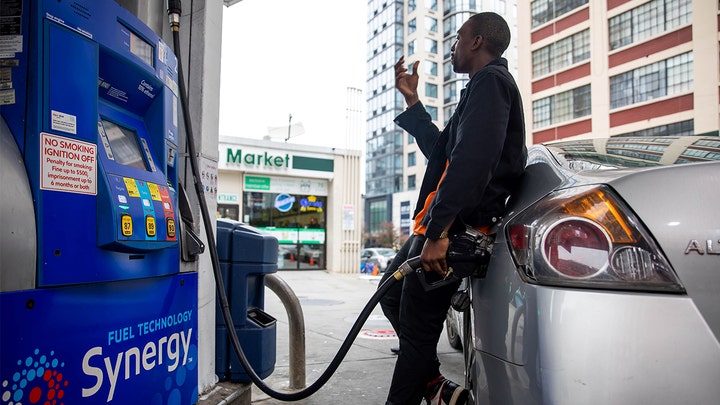
“The absence or insufficiency of cost-of-living adjustments in many state tax codes is always an issue, as it constitutes an unlegislated tax increase every year, cutting into wage growth and reducing return on investment,” Walczak wrote. “During a period of higher inflation, however, the impact is particularly significant.”
The analysis comes as the government released new data this week reporting that prices for U.S. consumers surged 6.2% in October compared with a year earlier. So-called core prices, which exclude the more volatile measurements of energy and food, rose 4.6% over the past year. Both are the largest increases in 30 years.
Rising inflation is eating away at strong gains and wages and salaries that American workers have seen in recent months (average hourly wages in the U.S. actually fell 1.2% last month compared with October 2020 when accounting for inflation).
Economists expect the spike to last well into 2022: A new Goldman Sachs analyst note published on Sunday warned that inflation metrics will remain “quite high for much of next year” until global supply chain bottlenecks clear up.
“It is now clear that this process will take longer than initially expected, and the inflation overshoot will likely get worse before it gets better,” the Goldman economists wrote.
最新!拜登银行监管新政,个人账户余额过$1万,IRS有权随时查账!
来源: 华人生活网
10/21/2021
0月20日,拜登政府放弃了一项有争议的提议,该提议要求国税局对每年交易金额超过600美元的所有银行账户收集更多数据。
该计划此前受到了共和党议员和银行业代表的广泛批评,称其税务执法策略代表了联邦政府对隐私的侵犯。
不过虽然该提议夭折,但是拜登政府并未完全放弃银行存款这一块的监管。
根据新规定,帐户余额超过1万美金,或者不包括薪资收入的存款、提款总额超过1万元,就会受到国税局加强检查;银行必须把帐户持有人的现金流导入导出汇整数据交给国税局,好让国税局锁定稽查目标。
民众注意的是通过工资收入获得的、自动扣除联邦税的收入的账户不计入其中。领取失业救济金和社会保障等联邦福利的人也可以豁免。
拜登表示:“很多富人为了逃税,每年从美国人民身上骗取数十亿美元。当适用于逃税行为的报告规则松散而模糊时,逃税行为就会猖獗起来。民主党人想要修复这个支离破碎的方法,打击高层的欺骗行为,”
财政部长珍妮特·耶伦(Janet Yellen)在会议上表示:“今天的新提案反映了政府的强烈信念,我们应该瞄准那些顶端的收入规模不付他们欠的税,同时保护美国工人通过设置银行账户阈值为10000美元,为工薪阶层提供豁免和教师和消防员一样。”
她表示,长期以来问题的核心是向IRS报告各种收入的方式存在差异:不透明的收入来源经常逃避审查,而工资和联邦福利通常几乎要完全遵守。这种双重税收制度是不公平的,剥夺了国家用于资助核心优先事项的资源。”
“新规定为了回应对范围的考虑,(国会)制定了一个新办法,包括对工薪阶层和工薪阶层以及联邦项目受益者的豁免。
这些变化将免除数百万美国人的申报要求,并帮助国税局将目标锁定在较富裕的美国人,特别是那些从投资、房地产和其他交易中赚钱的人,这些交易对国税局来说更难追踪。
最初的提议引起了共和党议员的愤怒,他们称这侵犯了隐私,是政府越权的一个例子。
即使修改了提案,参议院的共和党人仍然持批评态度。
爱达荷州共和党参议员迈克·克拉波(Mike Crapo)表示,拜登总统曾经承诺称,不会对年收入低于40万美元的美国人增税,他认为这一门槛应该适用于国税局的申报。
“他们为什么不直接颁布禁令,禁止美国国税局窥探年收入低于40万美元的人的账户呢?”我认为,这是这个方法的发起者应该问的问题。”
另外,银行业代表仍对任何额外的报告要求持怀疑态度,称这将造成负担,尤其是对小型社区银行。
据了解,该提案距离实施还有很长的路要走。该计划目前包括在数万亿美元的社会支出计划中,立法者和白宫已经协商了几个月。如果该方案获得通过并签署成为法律,这项要求要到2022年12月才会生效。
政府估计,税收执法的改善将在未来10年增加6000亿美元的税收收入。
美联邦国税局查帐门槛升至1万 仍遭质疑侵犯隐私
来源:世界新闻网
10/20/2021
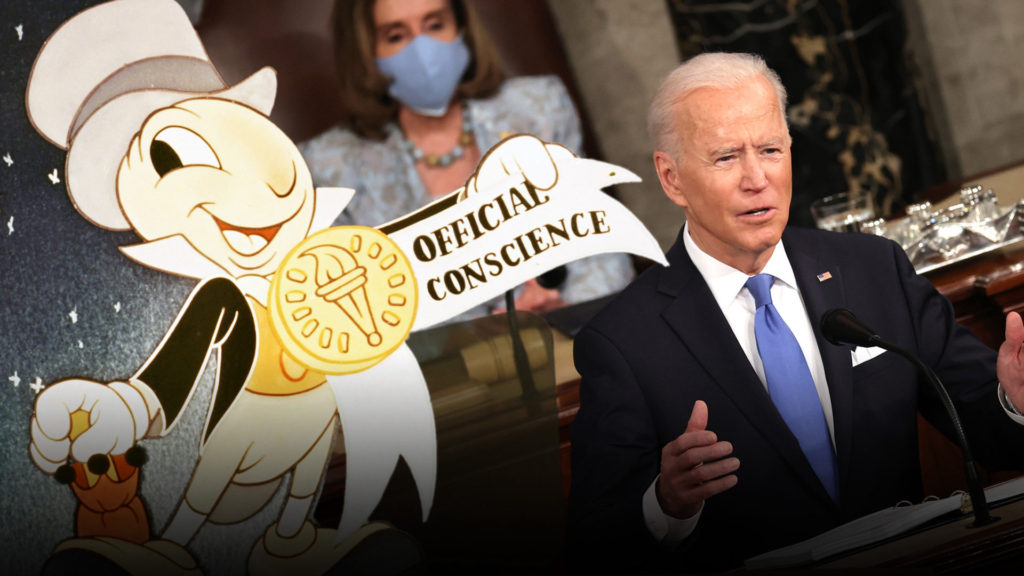
美国联邦国税局(IRS)拟查看所有存款馀额逾600元,或一年之内汇入汇出转帐额度超过600元的银行帐户,消息曝光后引发舆论强烈反弹;美国民主党籍国会议员19日达成协议,把查看帐户的适用对象改为存款馀额1万元以上帐户,但共和党方面则说,修正后的门槛仍侵犯民众隐私,“除非大家都不花钱。”
民主党籍麻州联邦参议员华伦(Elizabeth Warren)与参院财政委员会主席、民主党籍俄勒冈州联邦参议员魏登(Ron Wyden)19日下午公布修改后的新版政策。
根据新版规定,帐户馀额超过1万元,或者不包括薪资收入的存款、提款总额超过1万元,就会受到国税局加强检查;银行必须把帐户持有人的现金流汇入汇出彙整资料交给国税局,好让国税局锁定稽查目标。
彙整报告中的现金流不包括薪酬或工资所得,因为这部份原本就在国税局W-2报税表格权限范围;社安金支票也不会纳入现金流彙整报告统计。
国税局打算加强检视馀额600元以上帐户的计画,遭到共和党及金融机构极力反对,理由则是侵犯民众隐私;对于修正之后的新版规定,共和党国会议员也不接受。
共和党籍宾州联邦参议员图米(Pat Toomey)19日在记者会上说:“如果他们把门槛调高到1万元,适用对象仍然几乎包括所有人,还有所有商家。”
“民众平均帐户出入总额,约为6万1000元。”共和党籍爱达荷州联邦参议员克雷波(Mike Crapo)表示:“一般美国百姓都将成为这项计画的调查目标。”
帐户都被监视“除非大家不花钱”
克雷波说,排除薪水收入不计,其实影响不大,绝大多数民众的帐户还是将成为受到加强检视的对象,“除非大家都不花钱”。
面对共和党阵营批评,魏登回应指出:“共和党紧咬这个议题不放,用来做为扯谎藉口,原因是他们明白他们推出的税改政策其实非常失败。”
金融机构组织“美国独立银行家协会”(Independent Community Bankers of America,ICBA)发表声明指出,不管查看帐户的门槛是600元,1万元或10万元,适用对象都将包括数以百万计的消费者以及小型商家。
IRS:海外银行资产和金融账户申报10月15日截止
来源: 华人生活网
10/06/2021
很多华人即便入了美国国籍,但是在中国依旧有银行存款账户,也有人还有一些海外的生意。
大家要注意了,以下情况是要提交《国外银行和金融帐户报告》的。
在一个或多个帐户中有经济利益、有签字权或有其他权力,这些帐户包括在美国境外的银行帐户、经纪帐户、共同基金或其他金融帐户;日历年内任何时候所有外国金融帐户的总价值超过 1万 美元。
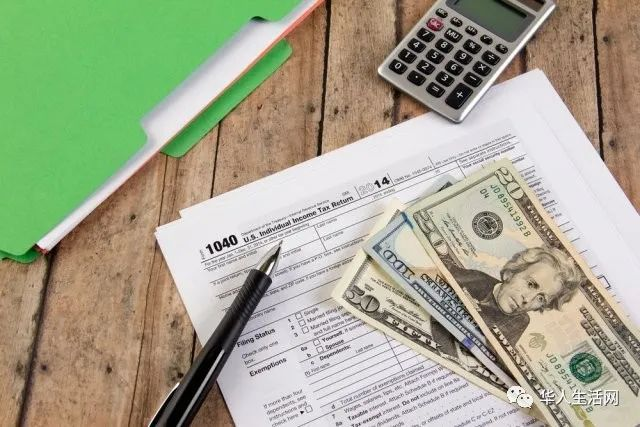
国税局(IRS)10月1日提醒美国公民、税法定义居民和任何境内法人实体,提交《国外银行和金融帐户报告》(FBAR) 的延期截止日为今年10 月15日。正常来说申报人若错过今年早些时候的 4 月 15 日年度截止日期,会被自动延期至 10 月 15 日提交FBAR,不需要申请延期。
国税局表示,申报人若受自然灾害影响,FBAR到期日可以要求进一步延长。重要的是,申报者须查看相关的FBAR 救援通知以获取完整信息。
目前由于1万美元这个界限的存在,国税局鼓励美国税务居民或拥有外国帐户的实体(即使是拥有相对较小的帐户),核查他们是否应就此报告申报。
美国税务居民指的是美国公民、居民或任何境内法人实体,例如合伙企业、公司、有限责任公司、遗产或信託。
国税局表示,申报人不应将FBAR与他们的联邦所得税申报表一起提交。
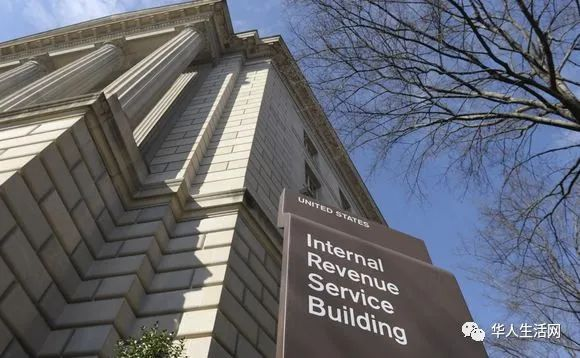
2020年FBAR必须以电子方式提交给金融罪行加强执法网络 (FinCEN),并且只能通过BSA电子申报系统网站递交。无法通过电子方式提交FBAR的纳税人必须致电金融罪行加强执法网络(FinCEN),美国境内拨打800-949-2732,美国境外拨打 703-905-3975。
凡未及时提交FBAR者,可能受到严重的民事和刑事处罚,可能导致罚款或监禁。
但若国税局确定延迟提交的原因合理,则不会惩罚那些延迟提交的FBAR 、报告外国帐户的人。
也有民众此前询问为什么经常看到5万美元的门槛,为什么此文中又说1万美元。这其实就是肥爸与肥咖的区别!
本月截止的是FBAR,也就是华人常说的肥爸。
“肥爸”﹙FBAR, Report of Foreign Bank and Financial Accounts ﹚是奥巴马政府于2009年5月发布税制改革“绿皮书”(The Green Book)中规定的,目的为严查美国境外所得税申报,以确定纳税人的境外所得完整申报,包含所有境外金融机构之账户,原先要求于2009年9月23日前需补申报海外账户。
后来,为了打击海外逃税,IRS又制定了“肥咖”(FATCA, Foreign Account Tax Compliance Act﹚。要求全世界各国银行交出美国税务居民金额美金5万以上的账户资料,企图在未来十年内追回估计超过85亿美元的海外逃税。两者在申报上也有许多区别:
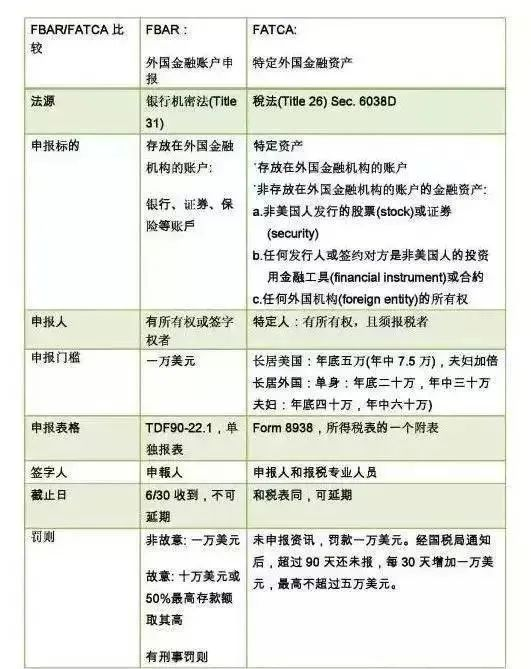
1 美元=6.47人民币
IRS: Oct. 15 FBAR extension deadline nears for foreign bank and financial account holders
IR-2021-196, October 1, 2021
WASHINGTON — The Internal Revenue Service reminds U.S. citizens, resident aliens and any domestic legal entity that the extension deadline to file their annual Report of Foreign Bank and Financial Accounts (FBAR) is Oct. 15, 2021.
Filers missing the April 15 annual due date earlier this year received an automatic extension until Oct. 15, 2021, to file the FBAR. They did not need to request the extension.
Filers affected by a natural disaster may have their FBAR due date further extended. It’s important filers review relevant FBAR Relief Notices for complete information.
Who needs to file?
The Bank Secrecy Act requires U.S. persons to file an FBAR if they have:
- Financial interest in, signature authority or other authority over one or more accounts, such as a bank account, brokerage account, mutual fund or other financial account located outside the United States, and
- The aggregate value of all foreign financial accounts exceeds $10,000 at any time during the calendar year.
Because of this threshold, the IRS encourages U.S. persons or entities with foreign accounts, even relatively small ones, to check if this filing requirement applies to them. A U.S. person is a citizen or resident of the United States or any domestic legal entity such as a partnership, corporation, limited liability company, estate or trust.
How to file
Filers do not file the FBAR with their federal income tax return. The 2020 FBAR must be filed electronically with the Financial Crimes Enforcement Network (FinCEN) and is only available through the BSA E-Filing System website. Those who are unable to e-file their FBAR must call FinCEN at 800-949-2732, or from outside the U.S. at 703-905-3975.
Avoid penalties
Those who don’t file an FBAR when required may be subject to significant civil and criminal penalties that can result in a fine and/or prison. The IRS will not penalize those who properly reported a foreign account on a late-filed FBAR if the IRS determines there was reasonable cause for late filing.
FBAR resources on IRS.gov:
- How to report foreign bank and financial accounts
- International Taxpayers
- IRS FBAR Reference Guide PDF
- FAQs About International Individual Tax Matters
- FinCEN’s website Reporting Maximum Account Value
To help avoid delays with tax refunds, taxpayers living abroad should visit Helpful Tips for Effectively Receiving a Tax Refund for Taxpayers Living Abroad on IRS.gov.
IRS: Report of Foreign Bank and Financial Accounts (FBAR)
Every year, under the law known as the Bank Secrecy Act, you must report certain foreign financial accounts, such as bank accounts, brokerage accounts and mutual funds, to the Treasury Department and keep certain records of those accounts. You report the accounts by filing a Report of Foreign Bank and Financial Accounts (FBAR) on FinCEN Form 114.
Who Must File
A United States person, including a citizen, resident, corporation, partnership, limited liability company, trust and estate, must file an FBAR to report:
- a financial interest in or signature or other authority over at least one financial account located outside the United States if
- the aggregate value of those foreign financial accounts exceeded $10,000 at any time during the calendar year reported.
Generally, an account at a financial institution located outside the United States is a foreign financial account. Whether the account produced taxable income has no effect on whether the account is a “foreign financial account” for FBAR purposes.
But, you don’t need to report foreign financial accounts that are:
- Correspondent/Nostro accounts,
- Owned by a governmental entity,
- Owned by an international financial institution,
- Maintained on a United States military banking facility,
- Held in an individual retirement account (IRA) you own or are beneficiary of,
- Held in a retirement plan of which you’re a participant or beneficiary, or
- Part of a trust of which you’re a beneficiary, if a U.S. person (trust, trustee of the trust or agent of the trust) files an FBAR reporting these accounts.
You don’t need to file an FBAR for the calendar year if:
- All your foreign financial accounts are reported on a consolidated FBAR.
- All your foreign financial accounts are jointly-owned with your spouse and:
- You completed and signed FinCEN Form 114a authorizing your spouse to file on your behalf, and your spouse reports the jointly-owned accounts on a timely-filed, signed FBAR.
Note: Income tax filing status, such as married-filing-jointly and married-filing-separately has no effect on your qualification for this exception.
The FBAR Reference Guide PDF) and FBAR instructions PDF provide more detailed information. The FBAR webinar explains how to calculate the aggregate value of your accounts to figure if you need to file an FBAR.
When to File
The FBAR is an annual report, due April 15 following the calendar year reported.
You’re allowed an automatic extension to October 15 if you fail to meet the FBAR annual due date of April 15. You don’t need to request an extension to file the FBAR.
If you are affected by a natural disaster, the government may further extend your FBAR due date. It’s important that you review relevant FBAR Relief Notices for complete information.
For certain employees or officers with signature or other authority over, but no financial interest in certain foreign financial accounts, the 2018 FBAR due date is deferred to April 15, 2020. See Notice 2018-1 PDF.
How to File
You must file the FBAR electronically through the Financial Crimes Enforcement Network’s BSA E-Filing System. You don’t file the FBAR with your federal tax return.
If you want to paper-file your FBAR, you must call FinCEN’s Regulatory Helpline to request an exemption from e-filing. See Contact Us below to reach this Helpline. If FinCEN approves your request, FinCEN will send you the paper FBAR form to complete and mail to the IRS at the address in the form’s instructions. IRS will not accept paper-filings on TD F 90-22.1 (obsolete) or a printed FinCEN Form 114 (for e-filing only).
If you want someone to file your FBAR on your behalf, use FinCEN Report 114a PDF, Record of Authorization to Electronically File FBARs, to authorize that person to do so. You don’t submit FinCEN Report 114a when filing the FBAR; just keep it for your records and make it available to FinCEN or IRS upon request.
Keeping Records
You must keep records for each account you must report on an FBAR that establish:
- Name on the account,
- Account number,
- Name and address of the foreign bank,
- Type of account, and
- Maximum value during the year.
The law doesn’t specify the type of document to keep with this information; it can be bank statements or a copy of a filed FBAR, for example, if they have all the information.
You must keep these records for five years from the due date of the FBAR.
Exception: An officer or employee who files an FBAR to report signature authority over an employer’s foreign financial account doesn’t need to personally keep records on these accounts. The employer must keep the records for these accounts.
Penalties
You may be subject to civil monetary penalties and/or criminal penalties for FBAR reporting and/or recordkeeping violations. Assertion of penalties depends on facts and circumstances. Civil penalty maximums must be adjusted annually for inflation. Current maximums are as follows:
| U.S. Code citation | Civil Monetary Penalty Description | Current Maximum |
|---|---|---|
| 31 U.S.C. 5321(a)(5)(B)(i) | Foreign Financial Agency Transaction – Non-Willful Violation of Transaction | $12,921 |
| 31 U.S.C. 5321(a)(5)(C) | Foreign Financial Agency Transaction – Willful Violation of Transaction | Greater of $129,210, or 50% of the amount per 31 U.S.C.5321(a)(5)(D) |
| 31 U.S.C. 5321(a)(6)(A) | Negligent Violation by Financial Institution or Non-Financial Trade or Business | $1,118 |
| 31 U.S.C. 5321(a)(6)(B) | Pattern of Negligent Activity by Financial Institution or Non-Financial Trade or Business | $86,976 |
Criminal penalty maximums are provided in the FBAR Resources below.
Filing Delinquent FBARs
Filing an FBAR late or not at all is a violation and may subject you to penalties (see Penalties above). If you have not been contacted by IRS about a late FBAR and are not under civil or criminal investigation by IRS, you may file late FBARs and, to keep potential penalties to a minimum, should do so as soon as possible. To keep potential penalties to a minimum, you should file late FBARs as soon as possible.
Follow these instructions to explain your reason for filing late. If you’re participating in an optional program to resolve FBAR noncompliance, such as Delinquent FBAR Submission Procedures or Streamlined Filing Compliance Procedures , follow the instructions for those programs.

Representation for FBAR Issues
You can file Form 2848, Power of Attorney and Declaration of Representative, if the IRS begins an FBAR examination as a result of an income tax examination (Title 26). Complete Line 3, acts authorized, as follows:
- Under Description of Matter – Matters relating to Report of Foreign Bank and Financial Accounts or “FBAR Examination”
- Under Tax Form Number – FinCEN Form 114
- Under Year(s) or Period(s) – applicable tax year(s)
(Note: Disregard previous guidance to complete Line 5a, additional acts authorized.)
Don’t use Form 2848 if a related income tax examination doesn’t apply. You may use a general power of attorney form executed under applicable state law.

FBAR Resources
- FBAR Reference Guide PDF
- Webinar: Reporting of Foreign Bank and Financial Accounts on the Electronic FBAR
- FBAR fact sheet
Note: Civil penalty maximums in these materials are no longer current, as these amounts are adjusted annually for inflation. See Penalties above for more information.
Contact Us
Can’t find the answer to your question in online information? Contact us.
| Contact | Business Hours | Help Offered | |
|---|---|---|---|
| IRS FBAR Hotline | 866-270-0733; or if calling from outside the United States, 313-234-6146 | Monday – Friday, 8 a.m. to 4:30 p.m. EST | General questions: FBAR filing requirements Filing methods |
| FinCEN’s BSA E-Filing Help Desk | See FinCEN’s website for contact information | Monday – Friday, 8 a.m. to 6 p.m. EST | Technical questions about BSA’s E-Filing System |
| FinCEN’s Regulatory Helpline | See FinCEN’s website for contact information | Leave a message for a return call | E-filing exemptions to allow FBAR paper-filingQuestions about BSA regulations |

IRS: Expanded tax benefits help individuals and businesses give to charity during 2021; deductions up to $600 available for cash donations by non-itemizers
IR-2021-190, September 17, 2021
WASHINGTON — The Internal Revenue Service today explained how expanded tax benefits can help both individuals and businesses give to charity before the end of this year.
The Taxpayer Certainty and Disaster Tax Relief Act of 2020, enacted last December, provides several provisions to help individuals and businesses who give to charity. The new law generally extends through the end of 2021 four temporary tax changes originally enacted by the Coronavirus Aid, Relief, and Economic Security (CARES) Act. Here is a rundown of these changes.
Deduction for individuals who don’t itemize; cash donations up to $600 qualify
Ordinarily, individuals who elect to take the standard deduction cannot claim a deduction for their charitable contributions. The law now permits these individuals to claim a limited deduction on their 2021 federal income tax returns for cash contributions made to certain qualifying charitable organizations. Nearly nine in 10 taxpayers now take the standard deduction and could potentially qualify to claim a limited deduction for cash contributions.
These individuals, including married individuals filing separate returns, can claim a deduction of up to $300 for cash contributions made to qualifying charities during 2021. The maximum deduction is increased to $600 for married individuals filing joint returns.
Cash contributions to most charitable organizations qualify. However, cash contributions made either to supporting organizations or to establish or maintain a donor advised fund do not qualify. Cash contributions carried forward from prior years do not qualify, nor do cash contributions to most private foundations and most cash contributions to charitable remainder trusts. In general, a donor-advised fund is a fund or account maintained by a charity in which a donor can, because of being a donor, advise the fund on how to distribute or invest amounts contributed by the donor and held in the fund. A supporting organization is a charity that carries out its exempt purposes by supporting other exempt organizations, usually other public charities. See Publication 526, Charitable Contributions for more information on the types of organizations that qualify.
Cash contributions include those made by check, credit card or debit card as well as amounts incurred by an individual for unreimbursed out-of-pocket expenses in connection with the individual’s volunteer services to a qualifying charitable organization. Cash contributions don’t include the value of volunteer services, securities, household items or other property.
100% limit on eligible cash contributions made by itemizers in 2021
Subject to certain limits, individuals who itemize may generally claim a deduction for charitable contributions made to qualifying charitable organizations. These limits typically range from 20% to 60% of adjusted gross income (AGI) and vary by the type of contribution and type of charitable organization. For example, a cash contribution made by an individual to a qualifying public charity is generally limited to 60% of the individual’s AGI. Excess contributions may be carried forward for up to five tax years.
The law now permits electing individuals to apply an increased limit (“Increased Individual Limit”), up to 100% of their AGI, for qualified contributions made during calendar-year 2021. Qualified contributions are contributions made in cash to qualifying charitable organizations.
As with the new limited deduction for nonitemizers, cash contributions to most charitable organizations qualify, but, cash contributions made either to supporting organizations or to establish or maintain a donor advised fund, do not. Nor do cash contributions to private foundations and most cash contributions to charitable remainder trusts.
Unless an individual makes the election for any given qualified cash contribution, the usual percentage limit applies. Keep in mind that an individual’s other allowed charitable contribution deductions reduce the maximum amount allowed under this election. Eligible individuals must make their elections with their 2021 Form 1040 or Form 1040-SR.
Corporate limit increased to 25% of taxable income
The law now permits C corporations to apply an increased limit (Increased Corporate Limit) of 25% of taxable income for charitable contributions of cash they make to eligible charities during calendar-year 2021. Normally, the maximum allowable deduction is limited to 10% of a corporation’s taxable income.
Again, the Increased Corporate Limit does not automatically apply. C corporations must elect the Increased Corporate Limit on a contribution-by-contribution basis.
Increased limits on amounts deductible by businesses for certain donated food inventory
Businesses donating food inventory that are eligible for the existing enhanced deduction (for contributions for the care of the ill, needy and infants) may qualify for increased deduction limits. For contributions made in 2021, the limit for these contribution deductions is increased from 15% to 25%. For C corporations, the 25% limit is based on their taxable income. For other businesses, including sole proprietorships, partnerships, and S corporations, the limit is based on their aggregate net income for the year from all trades or businesses from which the contributions are made. A special method for computing the enhanced deduction continues to apply, as do food quality standards and other requirements.
Keep good records
The IRS reminds individuals and businesses that special recordkeeping rules apply to any taxpayer claiming a charitable contribution deduction. Usually, this includes obtaining an acknowledgment letter from the charity before filing a return and retaining a cancelled check or credit card receipt for contributions of cash. For donations of property, additional recordkeeping rules apply, and may include filing a Form 8283 and obtaining a qualified appraisal in some instances.
For details on how to apply the percentage limits and a description of the recordkeeping rules for substantiating gifts to charity, see Publication 526, available on IRS.gov.
The IRS also encourages employers to help get the word out about the advance payments of the Child Tax Credit because they have direct access to many employees and individuals who receive this credit.
For more information about other Coronavirus-related tax relief, visit IRS.gov/coronavirus.


